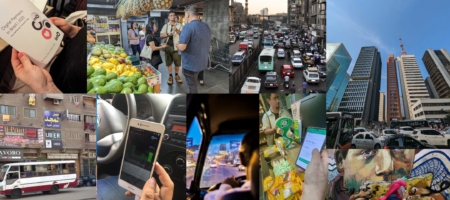Intro
During my time at the Royal College of Art, I’ve been inspired by the ‘design studies’ approach. These design studies are like case studies in business schools, and offer a conversational space focused on design practices and strategies. The aim is to inspire new ways of thinking about design direction and creating competitive advantages. With the design studies format in mind, I’ll be writing a series of mini-essays about my observations on services and customer behaviours. If you’re a design thinker like myself, or have a strategic role in shaping your product development or marketing positioning, I hope the articles might provoke and inspire thoughts of your own. At the end of the day, we all think differently.
A special type of service: utility services
Utility services are an interesting type of service. They provide everyday essentials to households, but customers tend to switch between brands much less often than non-utility services. For example, we use water and electricity everyday but we don’t change water supply and electricity supply that often because the different providers don’t differentiate that much in terms of meeting user needs or creating different experiences. This is reflected by the fact that, over recent years in the UK, increasing numbers of comparison sites (for example, USwitch, MyUtilityGenius – and many more) and services like Look After My Bills have launched. This has highlighted that there’s a market for businesses that aim to counter the apathy consumers feel towards switching utility providers (and potentially saving money).
Are digital services becoming the new utilities?
Now, it seems to me that internet services increasingly feel similar to utilities; consider music and video streaming services, news and even games. Most of the internet giants are beginning to offer entertainment within utility bundles for the home. For example, Amazon offers Amazon Prime membership as a way to bundle up the needs of home entertainment and online shopping. For many consumers, Amazon is becoming a utility for online deliveries. Apple is another example. Apple’s subscription-based offerings encompass music & podcasts, TV shows, news, fitness and games (and like Amazon, Apple has also started to offer a subscription bundle that includes all its services). There are probably even more examples emerging since the pandemic. It makes me wonder what the common characteristics of utilities are, and what we need to consider if we’re to design other digital services in line with the utility model.
The characteristics of utilities
Below, I highlight three themes that I’ve found interesting.
High frequency of usage
Typically, we use utilities like water & electricity frequently and extensively, each day. I can see a parallel here with the usage of digital services, which are often designed to win – and actively compete for – a user’s attention (both in terms of time and frequency). Over the years, companies have increasingly invested in mobile-first strategies that prioritise their presence on mobile platforms because audiences are spending more and more time on digital mobile devices. These mobile devices are acting almost like a high-street, where apps compete for traffic just as physical stores do on the high-street. As a result, competition to become THE category winner (e.g. THE music app on your phone) becomes vitally important because it’s rare for people to subscribe to two utility providers that meet similar needs. And as we’ve explored, switching providers happens less often compared to other purchases – despite high frequency and high-volume usage. So, one observation here is that digital subscription services should be designed to encourage high frequency usage. Without this, the user will switch from using it like a utility to wanting to use it per occasion. This really makes me think about the number of my friends who are reluctant to purchase adobe suite subscriptions. Adobe simply hasn’t built in a high usage frequency for many of its users.
Location-centred subscription
The second characteristic I’ve noted is that utilities are commonly supplied based on the ‘place’ they will be used. Home, for example, is a centre that holds many different utilities. This is probably why most entertainment subscriptions are created for home scenarios and why there is such a strong push (as mentioned previously with regard to Apple & Amazon) to become THE digital utility service for your home.
However, what are other places that feel ripe for digital utilities?
Vehicle is definitely an area of expansion for digital subscriptions. Progressive car manufacturers, like Tesla, offer electronic routing in map services, charging services, auto-driving, music and even video games within their digital subscription. These are becoming more and more important for the new end-to-end ownership experience. The integration of Spotify in Tesla cars was launched many years ago and recently became part of the subscription bundle for premium Tesla connectivity services. At the last WWDC, Apple released a wide range of digital services for its vehicle partners. For example, by using the Apple ID, users can share a digital key for their new BMW X5.
Vehicle as the next location for digital subscriptions is exciting. How can we design a new set of utility based services that enhance the experience of owning and driving a vehicle?
Office is another interesting environment for the future of digital utility services. As the pandemic forced many businesses to move from physical space to remote working, businesses will become more hybrid than ever – even when lockdowns are over. This means that there will be a need for both physical facilities and online facilities that enable work communication, collaboration, editing, production and storage – no matter where the physical location is. So, what are the utility-types of services required to blend that physical and virtual working environment? Will we be able to see an office provider (e.g. WeWork, Fora, Huckletree, Regus, etc.) that also provides a full range of virtual working suites? This feels like a real opportunity to me.
Of course, the demand and success of any location-based subscription requires critical research into the cultural contexts of specific markets, customer groups and countries. The new contexts of ‘remote working’ will be different in regions the world over, as will the expectations that drivers and families have for their vehicles.
The values of habit
Utilities or subscriptions ultimately form habits. These habits are created by long-term behaviour and reliance and can be hard to change. For many users or customers, any service with a value proposition that will help them create a positive habit is desirable. In the context of designing utility-like digital services, this means that there are plenty of value-add opportunities for users who want to optimise their behaviours. We have already seen a trend of users monitoring their usages on utilities and asking for smart optimisation to help them change their habits. Publications such as Tiny Habits by BJ Fogg, Atomic Habits by James Clear, Hooked by Nir Eyal, present compelling theory on this subject. By illuminating usage patterns, digital services can help users to understand themselves better. This is particularly valuable for empowering users to make behavioral changes and achieve life goals. For any digital service that wants to adopt the model of utility or subscription payment, an investigation into the meaning of habits (in relation to its value proposition) amongst its audience could be incredibly powerful. There’s an opportunity here to innovate in ways that transcend mere transactional engagement.
The strategy for next generation digital services?
Digital services have evolved a lot since the 2000s. When Steve Jobs merged digital devices and digital retail in such a ground-breaking and high-profile way – beginning with the iPod and iTunes, and later developing the iPhone and App store – the entire landscape of digital services began to change rapidly. That was THE strategy that has transformed industries and shaped user behaviours for two decades. So, after two decades, what’s the next strategy for digital services? Is utility-like digital strategy going to be the next idea that shapes the world? How can other companies compete with Apple or Amazon as they become the utilities for all essentials (from groceries to other consumables) and entertainment? These are questions that we should be prepared to answer.
Acknowledgements:
I want to give special thanks to the contributors of this article. Neal Stone, who was my tutor at RCA, is a great thinker and practitioner in the field of design (you can check his bio here https://www.linkedin.com/in/nealstone/). He has kindly given so much input to this article and helped me to improve this idea about new design strategy for digital services as utilities. Lead picture by Klim Musalimov at Unsplash.

Jonny is the Business Director at intO. With a background in service design, he has developed his craft and expertise in design research for innovation and business transformation, and is passionate about delivering transformative effects for clients and their customers. His work features a combination of holistic user-experiences and competitive advantages to shape business innovation. Find Jonny at LinkedIn here.
Posted on March 8th, 2021
Strategy Uncategorized




